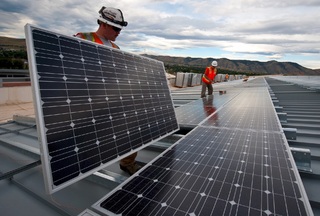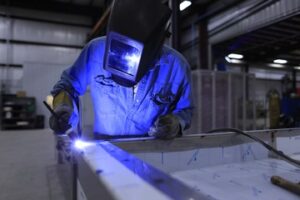
Metal fabrication and sheet metal fabrication are essential industries that support numerous sectors, including construction, automotive, aerospace, and manufacturing. The metal fabrication industry carries out a wide range of processes, including cutting, bending, and shaping metals into various forms and sizes, while sheet metal fabrication is a specialized branch of metal fabrication that focuses on creating sheet metal parts and products. These industries have been around for centuries, and they continue to evolve and adapt to meet the changing demands of modern society.
According to most research, the metal fabrication industry is expected to grow at a healthy rate in 2024. In this article, we will take a closer look at the reasons why sustained growth is expected as well as identify major industry trends for next year and beyond.
Current State of the Metal Fabrication Industry
The metal fabrication industry has experienced steady growth over the past few years, driven primarily by the increasing demand for metal products in various industries. According to a report by ResearchAndMarkets, the global metal fabrication market size was valued at $19.5 billion in 2020 and is expected to grow at a compound annual growth rate (CAGR) of 4.5% from 2021 to 2028.
Similarly, the sheet metal fabrication industry has seen significant growth in recent years, thanks to the increasing use of sheet metal in the construction, aerospace, and automotive sectors. The global sheet metal fabrication market size was valued at $17.2 billion in 2020 and is projected to grow at a CAGR of 2.7% from 2021 to 2028, according to the same report.
Business and Economic Outlook for 2024
The metal fabrication and sheet metal fabrication industry are expected to continue growing in the coming years, despite the challenges posed by the COVID-19 pandemic. The pandemic has disrupted global supply chains and caused a slowdown in economic activity in many parts of the world, but the demand for metal products has remained strong. Many factors have contributed to this continued growth.
9 Factors Driving Metal Fabrication Industry Growth
1. The increasing demand for manufactured goods.
One of the key drivers of growth in the metal fab industry is the increasing global demand for manufactured goods. As the global economy continues to grow, especially in places like China and India, there is a growing demand for manufactured goods. This demand is being driven by a number of factors, including the increasing population, the rising middle class in developing countries, and the growing demand for consumer goods.
2. The growing popularity of 3D printing and additive manufacturing
Another big catalyst of metal fabrication industry growth is the rise in popularity of 3D printing. 3D printing is an additive manufacturing process that allows manufacturers to create three-dimensional objects from a digital file, from materials like aluminum and stainless steel, but also plastics and other polymers. This technology has a number of advantages over traditional manufacturing methods, in particular for very low quantity, custom orders, including the ability to create complex shapes and products on demand, while reducing waste.
3. The need for new and innovative products.
Businesses are constantly looking for new and innovative products in order to stay competitive. This demand for new products is being driven by a number of factors, including the changing needs of consumers, the growing demand for customized products, and the need for products that are more efficient and affordable.
4. An ever-growing demand for more sustainable products.
Businesses are under increasing pressure to produce sustainable products that produce less waste while being as economical as possible. This trend is expected to drive the demand for metal fabrication services that can help businesses to produce products that are more efficient and sustainable.

5. Aerospace and automotive industry interest in lightweight materials.
Another factor driving the growth of the metal fabrication industry is the increasing demand for lightweight materials, particularly in the automotive and aerospace industries. Lightweight metals such as aluminum, titanium, and magnesium are becoming increasingly popular due to their strength, durability, and energy efficiency.
6. Construction industry’s desire for more energy-efficient building materials.
Increasing demand for energy-efficient building materials from the construction industry continues to drive growth in metal fabrication. Sheet metal products such as roofing, siding, and insulation are popular choices for construction companies looking to improve the energy efficiency of their buildings.
7. Adoption of automation and robotics in metal fabrication processes
One of the most significant trends in the metal fabrication and sheet metal fabrication industries is the increased use of automation and robotics. Automation and robotics can help increase efficiency, reduce costs, and improve safety in the manufacturing process. With advancements in technology, more companies are adopting automation and robotics to streamline their operations.
8. Sustainable manufacturing practices.
As environmental concerns continue to grow, the metal fabrication and sheet metal fabrication industries are embracing sustainable manufacturing practices. Companies are implementing eco-friendly processes and technologies to reduce waste, energy consumption, and greenhouse gas emissions. The trend towards sustainability is expected to continue in 2024 as metal fabricators prioritize environmental responsibility
9. Industry 4.0
Industry 4.0 refers to the integration of advanced technologies, such as the Internet of Things (IoT), artificial intelligence (AI), and big data analytics, into the manufacturing process. This trend is expected to continue to grow in 2024 as companies seek to improve efficiency and productivity in their operations.
Challenges for Metal Fabricators in 2024 and Beyond

Despite promising growth prospects, the metal fabrication and sheet metal fabrication industry face several challenges, including issues like fluctuation of the cost of raw materials, as well as their availability due to potential supply chain issues. But the biggest might very well be the shortage of skilled workers, particularly welders and CNC machinists. The industry needs to invest in training and education programs to attract and retain skilled technicians.
Conclusion
The metal fabrication and sheet metal fabrication industries are expected to continue to grow in 2024, driven by increasing demand for durable and lightweight materials, rising infrastructure investments, and advancements in technology. Industry trends, such as automation and robotics, sustainable manufacturing, additive manufacturing, and Industry 4.0, are expected to shape the future of these industries. Companies that adopt these trends and embrace innovation are likely to thrive in the years ahead.





